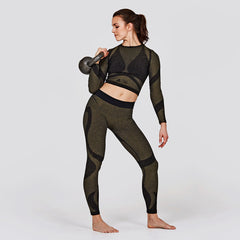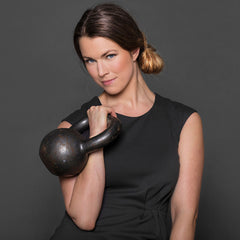
Vital muscles
On New Year's Eve 2012, I lost my mother to breast cancer.
She was only 50 years old.
Physical activity was not her thing as an adult; on the contrary, she didn't like to sweat at all.
But I know how vital muscles are for our immune system, among other things, and she needed to have as much muscle mass as possible during her chemo treatments. She just didn't have the strength to do that when she got sick, and it was hard for me to see my mother weaken so much.
We naturally lose muscle mass over the years, which is why it's vital to train our muscles. Not just to keep them, but also to build more. It's our health insurance in case something goes wrong and we're immobilized for a period of time.
Research has known for almost a decade that strength training is one of the most effective tools for preventing cancer, increasing cancer survival and minimizing pain and side effects after cancer treatment.
That's why you, especially as a woman, should strength train.
That's it in a nutshell.
"You can reduce your risk of breast cancer by up to 25% by being physically active - and studies show that strength training is significantly more effective than cardio."
Yet year after year, the focus is only on running, cycling, and sweating for our breasts - on strengthening our fitness - while muscle mass continues to be neglected.
This year - and in the future - I will focus on lifting (heavy) for the breasts.
Would you like to join me?
Lift something heavy - and share something that makes it lighter
#liftforyourbreasts
My mother's story is the reason I will never stop strength training
Or talking about how vital strength training is.
And teaching other women how to strength train.
A tour de force against cancer
That's what it takes. An all-out effort - but not the sweaty, exhausting and unmanageable kind. You need to exert yourself to overcome resistance, because that's the only way to get your fast-twitch muscle fibers talking (read more about fast-twitch muscle fibers here), which have the power to both shape and fine-tune your body's functions.
But you can do it for as little as 5 minutes a day to reap both the aesthetic and health benefits:
→ Prevention against certain cancers, including breast cancer
→ Increased chance of survival once affected by certain cancers
→ Increased tolerance for the harsh treatments that are often required for cancer patients.
What's the magic behind strength training?
As we age, we lose muscle mass. If you get cancer, it will happen faster. But muscle mass has a huge impact on how well you can withstand the harsh treatments the disease requires. The more muscle mass you have, the better you'll be able to withstand the treatment* - which is why it's so vital to build up your muscles for 'bad times' with high-quality strength training.
When muscles contract powerfully during strength training with good muscle contact and heavy load, they secrete hormone-like substances - myokines - which have both an immune-boosting and anti-inflammatory function. The focused muscle work also directs so-called NK cells (Natural Killer Cells) against tumors and induces tumor cell death.
It takes sufficient effort - preferably with full-body exercises involving several large muscle groups - to activate the highest possible production of myokines!

With the right (strength) training, your own body can do something amazing!
Strengthen your own immune system and thus better prevent cancer, but also activate and boost your own immune system if you do get cancer.
Blog links

EXERCISE LESS AND GET BETTER RESULTS
You can exercise for only 5 minutes daily (or several times a day if you have the energy) - and still receive the health benefits of high-quality strength training. Find out how in this blog post..

WHAT I WISH I WOULD HAVE KNOWN BEFORE MY MOTHER GOT SICK
I share about my mum's battle against cancer, which made me realise the importance of muscle building - and a strong body that gives us something to stand up for if the worst happens.
Strength training reduces late effects and relieves pain
Many cancer patients experience late effects such as severe pain and reduced mobility after their treatment, and I meet many women who are afraid to strength train (or exercise at all) if they have had surgery and are still in pain - and many who have been told after breast surgery, for example, that they are not allowed to lift heavy with the side they have had surgery on. But this is simply not true!
The latest research from Aalborg University in Denmark shows that...
- Strength training can help relieve persistent pain and discomfort after cancer.
- Breast cancer survivors can exercise in much the same way as non-cancer patients, so you don't need to be afraid of lifting heavy weights (there are exceptions, of course, so always check with your doctor).
You can strength train and you can lift heavy.
If you've had breast surgery, studies show that if you start by strengthening your arm without a limit on how heavy you can lift, you can regain full function.
This is a crucial step towards getting moving again without the fear of provoking something 'bad'. Always respecting your ability while gradually working to expand your comfort zone.
Strength training has a pain-relieving effect on most survivors
The study at the Department of Medicine and Health Technology at Aalborg University in Denmark shows that strength training with free weights had a pain-relieving effect to a greater or lesser extent in more than half of the women who participated.
The researchers do not yet have an exact answer as to why, but suggest that it seems that regular strength training leads to adaptations in the nervous system that make you less sensitive to pain.
Strength training can reduce the negative effects of treatment
Chemotherapy, radiation, anti-hormone therapy, surgery - cancer treatment can have a number of negative side effects such as weakening both bone and muscle mass.
However, studies with breast cancer patients and others have shown that strength training increases both their bone and muscle mass, making them stronger and more resilient.*
You can start strength training even if you don't have the energy
It's not new that exercise and physical activity play a major role in prevention, treatment and life after serious illness (although it's only recently that specific strength training has been recommended by the Danish Health Authorities). But it's one thing to be told what to do. It's another to know how to do it. And actually getting it done. Especially if your energy levels have been depleted during an illness. The result is often that it seems like a daunting project.
This is where micro-training comes in. Small, 5-minute strength training sessions that don't exhaust you mentally beforehand or physically along the way. That don't just work for the 5 minutes you're standing with a kettlebell or bodyweight, but actually start there. Like a domino piece you push through training, which then sets off a systemic chain reaction of good effects.
5 minutes that are much easier to manage every day than 30-60 minutes a few times a week.
* SOURCE:
Combined resistance and aerobic exercise program reverses muscle loss in men undergoing androgen suppression therapy for prostate cancer without bone metastases: a randomized controlled trial
Impact of resistance training in cancer survivors: a meta-analysis
Impact of resistance and aerobic exercise on sarcopenia and dynapenia in breast cancer patients receiving adjuvant chemotherapy: a multicenter randomized controlled trial
More on late effects, strength training and small steps
Blog links

WHAT COCO CHANEL AND "THE LITTLE BLACK DRESS" CAN TEACH YOU ABOUT EXERCISE
Coco Chanel created the dress that freed women from constricting corsets and allowed them to breathe freely. This is the inspiration behind the Anna Bogdanova Method - the 'little black dress' of exercise.

WHEN YOU DON'T EVEN HAVE THE TIME OR ENERGY FOR A 15-MINUTE WORKOUT
Craving a fitness plan for hectic times and do you ever look at yourself from the outside and think: "Honestly, how can you not even find 5-15 minutes to exercise? You need a damage control plan - Here's my secret


